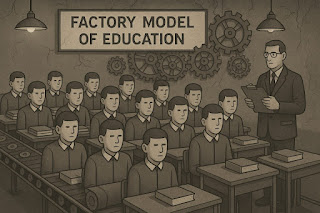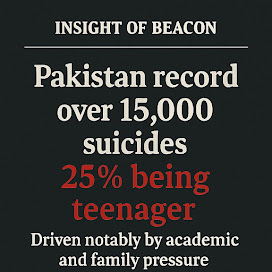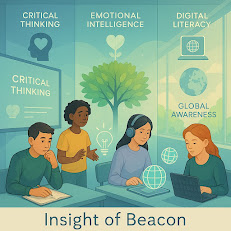Why Schools Still Teach Like They Did in 1925 — and How It’s Holding Us Back
Imagine spending your whole life training to win horse races, only to discover that the world now moves on high-speed trains. For millions of students around the world, that’s what modern schooling feels like — outdated, directionless, and dangerously disconnected from real life.
Despite living in the age of Al, space exploration, and remote work, most of our schools still operate much the same way they did a century ago, with desks, chalkboards, bell schedules, and a relentless obsession with grades.
- But why is education frozen in time?
- And what harm is being done by silence?
LIFE HIGHLIGHT
I still remember the day I started hating school. I was 18. I had spent an entire week making a little project — something creative, something I was proud of. But when I showed it to my teacher, he barely looked at it and said, “That wasn’t on the syllabus.” And it wasn't happen to me for the first time...
That sentence hit me harder than any test I’d ever failed.
This article isn’t just words. It’s me screaming what I wish someone had told me years ago: Our education system is broken — not because kids don’t try, but because the system doesn’t care about what really matters.
The Model Of Factory Education: Still Stuck in the Past:
The traditional school system was designed to prepare students for factory jobs during the Industrial Revolution. Punctuality, obedience, and repetition—not creativity, curiosity, or critical thinking—were valued traits. Many classrooms today still resemble small factories.
- One-size-fits-all lessons
- Fixed periods like work shifts
- Memorization on demand
- Assessment through standardized testing
As the world evolved, education didn’t.
Marksheet Mindset: When Numbers Define Intelligence:
From the first grade, students are trained to chase numbers. 90% means success. Anything less? Failure. The obsession with numbers turns learning into a journey, not a race. It creates.
- Anxiety, lack of understanding
- Competition, no collaboration.
- Short-term cramming, long-term growth.
Teachers often teach for the exam, not for the student. Students memorize formulas without knowing why they exist. Creativity becomes a “waste of time.” Asking questions is often punished rather than praised.
And then comes the accident.
Real-world awakening: Marks don’t pay the bill:
Once school is over, reality hits hard.No one asks your grade in 10th grade in a job interview.Life doesn’t give you multiple-choice questions.Success now requires what schools often ignore.
- Emotional intelligence
- Communication and teamwork
- Problem solving
- Adaptability to change
- Self-learning and curiosity
A student with perfect grades may struggle in the real world, while a creative thinker who never topped the class may start the next tech revolution. But our system rarely nurtures the latter.
Wasted potential: time, talent, and dreams:
Every year, millions of young minds are trapped in a system that teaches them what to think, not how to think. Instead of encouraging them to explore, question, or innovate, they are forced to memorize dates, definitions, and equations without context.
Students spend 12-16 years in school, yet many are unsure of how taxes work, how to manage mental health, or how to identify misinformation. This isn’t just failure – it’s theft. It steals their time, talent, and potential.
India
In 2021, 13,089 student suicides were reported (up from 12,526 in 2020) - one student every hour
en.wikipedia.org
South Korea
Highly competitive academic culture: ~46% of Seoul high school students report depression; Academic stress is a major trigger for youth suicide.
en.wikipedia.org
China
In 2013, 79 suicides among schoolchildren were linked to exam stress. 22% of youth suicides were directly related to academic stress.
en.wikipedia.org
Pakistan
More than 15,000 suicides are recorded in Pakistan annually, of which about 25% are adolescents - mainly due to academic and family pressures
tnn.com.pk
tribune.com.pk
In 2019, nearly 1,100 students committed suicide, with failure in exams cited as the main reason
thenews.com.pk
pakistantoday.com.pk
WHO data places youth (15-29) as the fourth largest age group affected by suicide, with academic stress highlighted as a major contributing factor.
2. Notable Tragic Incidents
DG Khan (March 2025):
A student jumped to his death during board exams - CCTV footage showed him under extreme stress
nation.com.pk
en.dailypakistan.com.pk
dawn.com
Lahore (June 2022):
An 18-year-old hanged himself at home after failing a difficult exam.
pakistantoday.com.pk
nation.com.pk
thenews.com.pk
Swat (May 2023):
Distraught over poor performance in SSC exam, Ayub Khan shoots himself. Experts highlight exam-focused grading system as part of the problem.
propakistani.pk
Peshawar (November 2023):
Zoology student Mubashir Ali took to sleeping pills after failing MDCAT, even citing high-stakes entrance exams as a trigger (Islamia university peshawar)
What should education be like in the 21st century?
We don’t need minor reforms, we need revolution. A new kind of education
- Values questions over answers.
- Embraces failure as part of learning.
- Connects lessons to real life.
- Focuses on skills, not just subjects.
- Personalizes the learning journey.
- Teaches how to learn, not just what to learn.
Imagine schools where students create projects, solve real-world problems, start small businesses, explore coding, learn mental health, or collaborate globally. This is not fantasy - it’s already happening in progressive models around the world.
1. Finland
🌟 Key features:
- No standardized testing till age 16
- Minimal homework and short school hours
- Focus on individual learning pace
- Highly qualified teachers with autonomy
- Emphasis on sports, arts, and emotional well-being
Result: Finnish students rank high in global education (PISA test) with low stress and high life satisfaction.
2. Netherlands
🌟 Key features:
- School starts at age 4 but with play-based learning
- No academic grading pressure in the early years.
- Strong focus on mental health and social skills
- Freedom to choose subjects and learning path
Result: Dutch students are consistently ranked among the happiest in the world (UNICEF report).
3. Canada
🌟 Key features:
- Experts balance approach between education and life skills
- No national exam pressure like NEET or MDCAT equivalent.
- Schools provide counseling, inclusion, and learning support.
- Respect for cultural diversity and mental health
Conclusion: Canada ranks very low in literacy, life satisfaction, and future preparedness, with low dropout rates and low student anxiety.
Conclude From Marks to Meaning:
The problem is not that education exists. The problem is that it's frozen in the past. We don't need to destroy the system we need to change it.
Because in the real world, it's not about who got the highest marks.
It's about who can make the mark.
Learning , Teaching And The Human Condition
- John Holt
- School often create anxiety and mental pressure,rather then curiosity.
2.Orya Maqbool Jan
"Our education has become a system of slavery - where thinker are the one who always fail."
- Reflect on how creative and independent minds are punished,not nurtured.
3.George Carlin
"The whole purpose of education is to train people not to think - to accept the status quo,obey rules,and never question authority"
- Show how limits real human freedom are.




















0 Comments